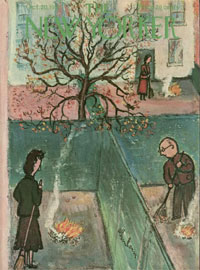 |
PROFILES
THE
DAYS OF DUVEEN
IV ~
B. B.
S. N. Behrman
The New Yorker October 20, 1951: 36-59 |
Lord Duveen of Millbank, the most famous art dealer in history, loved walking. Especially did he love walking through art galleries and along the Fifty-seventh Streets of the world. On his walks, he usually had with him a disciple or an eager customer, whom he would harangue on his favorite topic—indeed, his only topic: art. The wares he saw displayed in the windows of competitors often stirred him to fury. He would pound the sidewalk with his walking stick, shouting "Rot! Fake! Nonsense!" so loudly that passersby, whose immediate concerns were remote from Duveen's, would halt and marvel that a few daubs in a window could arouse such expletive passion. In his walks through public galleries, Duveen was less choleric; to be sure, he did not own the paintings displayed in them, but then neither did his competitors. This peripatetic method of instruction was wholly non-Socratic; Duveen did all the talking. He had everything to tell his pupils; his pupils had nothing to tell him. Two doughty American aficionados of medieval armor, Clarence Mackay and William Randolph Hearst, received ambulatory instruction from Duveen on the minutiae of ancient jambs, vambraces, and cuirasses. Other pedestrian companions were Jules Bache, Andrew Mellon, Ramsay MacDonald, Mrs. Arabella Huntington, and Mrs. Horace E. Dodge. Actually, Duveen would take a walk with anybody who was willing to listen and who could afford to satisfy, someday, the desire he kindled.In all the years of Duveen's ascendancy, only one companion on his walks ever reversed Duveen's role. With this companion, the teacher was the pupil, the haranguer the haranguee, the oracle the listener. On these very special walks Duveen's instructor was Bernard Berenson, an American expatriate who lived, as he lives today, in Italy. Berenson was no mean walker himself. He was schoolmaster to a little strolling group of his own, but between the memberships of the two schools there was a disparity that could be measured only in light-years. The two schools had only one member in common—Duveen, master in his own, pupil in the other. Edith Wharton took walks with Berenson and was inspired to write a novelette in which the hero, like Berenson, became devoted to Early Italian art. Another stroller with Berenson was Marcel Proust; embedded in his great book are many reflections on art that passed through the fine filter of Berenson's scholarly mind. Still another fellow-pedestrian was Sir Kenneth Clark, later the director of the National Gallery in London and one of the most eminent living writers and lecturers on art. Another was John Walker, the distinguished Chief Curator of the National Gallery in Washington, who still goes to Italy at the drop of a hat to amble with Berenson. So does Dr. Alfred M. Frankfurter, the scholarly editor of Art News. Duveen's earliest walks with Berenson resulted in a notable feat of transubstantiation. Without moving from I Tatti, his lovely villa outside Florence, Berenson became the keystone of Duveen's remarkable career. Duveen acquired Berenson's eye, marketed his intuitions, grafted onto himself his instructor's opinions, authority, scholarship, and conscience.Berenson, a Bostonian of Lithuanian-Jewish origin, graduated from Harvard in 1887. A photograph of Berenson at Harvard—reproduced in Morris Carter's book "Isabella Stewart Gardner and Fenway Court," which deals with Mrs. Jack Gardner, the celebrated Boston hostess and art collector—shows an extraordinarily sensitive and romantic profile and a superabundance of curly dark locks (they are locks, not merely hair), reaching to his braid-bordered coat collar. The photograph reveals intensity and a hint of flamboyance, suggesting the Orient rather than the Baltic littoral. Logan Pearsall Smith, who became Berenson's brother-in-law, remarks in his volume of reminiscences, "Unforgotten Years," that there were two intellectuals at Harvard when he was there—George Santayana and Berenson—and also conveys the idea that he himself did not have enough intellectual equipment to approach them. At Harvard, Berenson quickly impressed his elders, if not all his contemporaries. In a journal that he kept during the Second World War, while a generous Italian friend was hiding him, near Florence, from the Germans, and that has been published in Italy, he records that he found his elderly professors far more accessible than the undergraduates. Instinctively, he gravitated to the society of his mentors—William James, Charles Eliot Norton, Barrett Wendell, Crawford Howell Toy, and Charles Rockwell Lanman, the last his professor of Sanskrit. He also became a fixture at the salons of Mrs. Gardner, who felt in this fervent undergraduate an incalculable intellectual promise. From the notoriously volatile Norton, Professor of the History of Art, he received an affection that had in it a certain ambivalence, and from Mrs. Gardner an affection that had in it no ambivalence whatever. It was Berenson who eventually selected for her the chief masterpieces in the famous collection at Fenway Court, her home in Boston. Later generations of Harvard undergraduates had to pay a dollar to visit Mrs. Gardner's palace on a selected day each year and view the paintings she had collected on Berenson's advice; the young Berenson, in his Harvard days, was allowed to come to see her any time he liked, for nothing....MORE

The courtyard of Mrs. Gardner's home, now the museum and site of the $500 million art theft
The stolen art
Previously:
Duveen, The Greatest Salesman in the World: Early Days